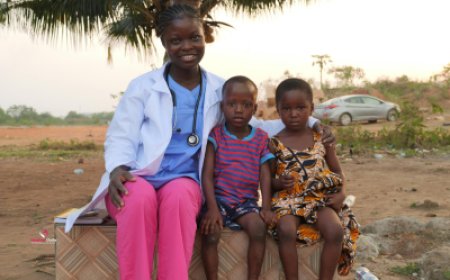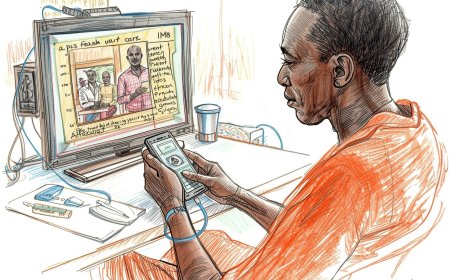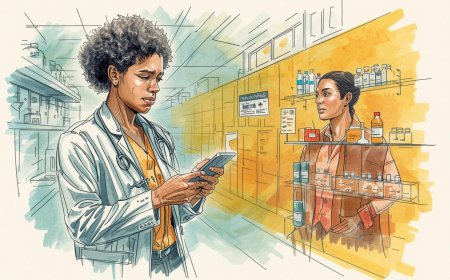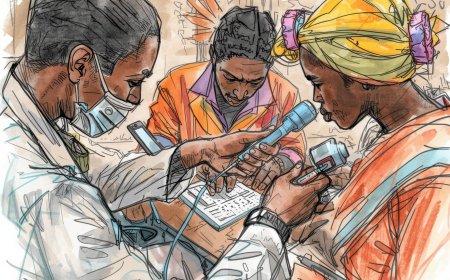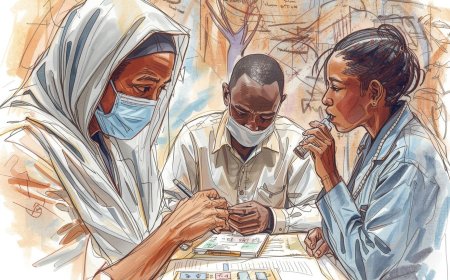Cost–Benefit: Demonstrating ROI for Clinical Decision-Support System (CDSS) Deployments in Africa
Decision-support systems can improve quality and safety in African health systems — but buyers and funders ask the same question: what is the return on investment (ROI)? This APA-style article for an African audience explains why ROI matters, which costs and benefits to measure, pragmatic study designs to demonstrate value, sample economic models, real African case evidence, common pitfalls, and a 12-step operational checklist hospitals and ministries can use to build a credible ROI case for CDSS procurement and scale-up.

Abstract
Clinical decision-support systems (CDSS) — digital algorithms, prompts and guideline engines used at point of care — promise better care, fewer unnecessary tests and medicines, and improved system efficiency. Yet African health ministries, hospital boards and funders commonly withhold scale funding until a clear return on investment (ROI) is demonstrated. This paper explains how teams should design ROI studies for CDSS in African contexts, what costs and benefits to include, simple and more rigorous economic evaluation methods, and pragmatic evidence-generation strategies (retrospective costing, pilot randomized or stepped-wedge studies, decision-analytic modelling, and prospective before-after impact monitoring). We draw on African case examples (ALMANACH, QUALMAT/ANC CDSS, ePOCT and other CDSS pilots) to show typical cost components and benefit pathways and provide a 12-step checklist and sample spreadsheet formulas founders and health system leaders can use to produce credible, decision-grade ROI evidence. BioMed Central+2BMJ Open+2
Introduction — why ROI matters in African CDSS decisions
Procurement and scale of CDSS in Africa commonly hinge on finance-driven questions: will this save money, free clinician time, reduce referrals, lower medicine spend, or improve outcome metrics that payers care about? Unlike purely research pilots, procurement decisions require believable economic evidence that maps costs to tangible benefits for the buyer (facility, county ministry, insurer, donor). Demonstrating ROI is therefore not optional — it’s central to commercial and public-sector scale. The evidence base for CDSS cost-effectiveness in Africa is promising but still limited and context-sensitive, so local ROI studies are usually necessary. MedRxiv+1
What counts as costs and benefits (the basics)
Costs (typical CDSS cost categories to include)
-
Capital & start-up
-
Software licensing or development; servers or cloud fees; one-off integration to hospital information systems; tablets/smartphones.
-
-
Implementation
-
Localisation, clinical guideline customization, training, data migration, piloting and acceptability work.
-
-
Operating costs
-
Ongoing hosting, maintenance, support desk, software updates, device replacement, mobile data or airtime, transaction fees (if payments involved).
-
-
Human costs
-
Extra clinician or data-entry time per consultation (or saved time), supervision and stewardship (committees), local IT staffing.
-
-
Opportunity & indirect costs
-
Disruption during roll-out, supervision visits, or any increased referral/treatment costs that arise. BioMed Central+1
-
Benefits (how CDSS typically creates value)
-
Direct clinical cost savings
-
Reduced unnecessary antibiotic prescriptions, fewer unnecessary tests or imaging, and shorter lengths of stay. (ALMANACH and related CDSS showed large antibiotic reductions in outpatient pediatrics.) PubMed+1
-
-
Avoided downstream costs
-
Avoiding adverse events, complications, or costly referrals (e.g., identifying sepsis early).
-
-
Efficiency gains
-
Faster consultations, lower clinician time per case, reduced re-work and documentation time.
-
-
Revenue/procurement effects
-
Better coding and billing capture (where fee-for-service exists), improved payer contracting due to measurable quality.
-
-
Population/outcome gains with economic value
-
DALYs averted, lives saved, improved maternal/neonatal outcomes that can be converted to cost-effectiveness metrics. PLOS+1
-
Evidence from Africa — what studies show
-
ALMANACH & pediatric CDSS — Trials and implementation studies have demonstrated improved clinical outcomes and large reductions in unnecessary antibiotic prescribing, a direct cost and antimicrobial-stewardship benefit. These clinical gains translate into potential cost savings from lower drug spend and reduced resistance-related costs. PubMed+1
-
QUALMAT / ANC & childbirth CDSS (Tanzania) — Intervention costing work found that installing and running maternal CDSS had measurable financial and economic costs (e.g., ~$28k–$35k per facility for 24 months depending on costing approach) and small improvements in process quality; cost-effectiveness was sensitive to assumptions about outcomes and scale. This highlights that unit costs can be substantial in small, rural centres but that scale and productivity change the ROI math. BioMed Central+1
-
ePOCT and modern pediatric CDSA trials — Recent randomized and cluster trials in low-resource settings show improved diagnostic quality and, in some designs, better patient-level outcomes; economic analyses alongside these trials (or subsequent modelling) form credible inputs for ROI cases when linked to local cost data. PMC+1
-
Other impact areas — CDSS deployed for chronic disease management and HIV retention have been associated with process improvements and better retention in care; translating these to economic benefit requires modelling avoided morbidity and service use. PMC
Overall, African evidence shows plausible benefit pathways — especially via reduced inappropriate prescribing and improved adherence to guideline-based care — but cost-effectiveness depends heavily on local prices, clinician time impacts, and scale. MedRxiv+1
Practical economic evaluation approaches (from simplest to rigorous)
Choose an approach matched to audience and time/budget:
1. Simple cost-savings (budget impact) model — fastest, buyer-friendly
-
Purpose: show whether the CDSS can pay for itself within a defined time horizon (e.g., 12–36 months).
-
Method: estimate per-consultation cost change = (∆drugs + ∆tests + ∆referrals + ∆clinician time valued) − (per-consultation share of operating cost). Multiply by expected consultations over the horizon to get net savings.
-
Use when buyers need fast procurement decisions.
-
Example formula (spreadsheet):
Net savings per period = (Baseline drug spend per consult − Post-CDSS drug spend per consult) * n_consults − (annual operating costs / n_consults_per_year). BioMed Central
2. Cost-effectiveness analysis (CEA)
-
Purpose: compare cost per health outcome (e.g., cost per DALY averted, cost per life saved, cost per 1% improvement in process quality).
-
Method: use trial or pilot outcome data (or decision model) to estimate health impacts and divide incremental cost by incremental effect. Use sensitivity analysis. This was used in QUALMAT analyses for ANC/CDSS. BioMed Central
3. Decision-analytic modelling (Markov or decision tree)
-
Purpose: capture downstream effects (e.g., downstream hospitalisations avoided, resistance trajectories) that small pilots cannot observe directly.
-
Method: combine local cost inputs with literature estimates for probabilities and utilities; run probabilistic sensitivity analysis. Useful when outcomes take time or are rare.
4. Stepped-wedge or cluster-randomized economic evaluation
-
Purpose: embed rigorous cost and outcome measurement in implementation.
-
Method: collect micro-costing data, process metrics and clinical outcomes alongside randomized roll-out; compute incremental cost-effectiveness and budget impact. High credibility but requires funding and time. PMC
Key metrics funders and buyers care about
-
Payback period — months until cumulative savings offset start-up + operating costs.
-
Net Present Value (NPV) and Internal Rate of Return (IRR) — for longer horizons and when capital costs matter.
-
Cost per avoided antibiotic prescription or cost per % reduction in inappropriate prescriptions — tangible for stewardship programs.
-
Cost per DALY averted / cost per life saved — for policymakers and donors comparing health investments.
-
Per-patient per-year net cost — helpful for insurers and employers.
-
Operational KPIs — average time saved per consult, reduction in referral rate, reduction in diagnostic tests ordered. Collect these as intermediate outcomes. OUP Academic+1
Data collection & costing practicalities (how to get credible inputs)
-
Micro-costing of the intervention — list all inputs (capital, recurrent, staff time) and measure unit costs locally; use procurement invoices for verifiable numbers. BioMed Central
-
Measure current practice (baseline) — sample consultations to estimate drug/test/referral rates and clinician time. Use health-facility records or short observation studies.
-
Measure intervention effects — pilot with before/after or randomized design; collect the same metrics.
-
Include shadow pricing for clinician time — value clinician time at salary cost divided by productive hours, not market consultancy rates.
-
Adjust for scale economies — model how per-consultation fixed costs fall as user numbers grow (critical: small pilots often show unattractive unit costs that improve with scale). BioMed Central
Sample ROI / Budget-impact worked example (simplified)
Assume county hospital with 20,000 outpatient primary care consults/yr.
-
Start-up cost (first year amortised): USD 20,000 (software, integration, devices).
-
Annual operating: USD 10,000 (hosting, support, data).
-
Baseline antibiotic spend/consult = USD 1.50; post-CDSS = USD 0.60 (due to guideline adherence) → saving USD 0.90/consult.
-
Other savings (reduced tests/referrals + clinician time) estimate USD 0.10/consult.
-
Net saving/consult = USD 1.00. Annual gross saving = 20,000 * 1.00 = USD 20,000.
-
Net first-year position = USD 20,000 gross − (start-up + operating = 30,000) = −USD 10,000 (payback not yet achieved). From year 2, annual net = 20,000 − 10,000 = USD 10,000; payback in year 3.
This simple example shows how scale and per-consult saving assumptions drive payback; sensitivity analysis on antibiotic reduction and consultations is essential. (Use local numbers; replace USD with local currency.) PubMed+1
Common pitfalls and how to avoid them
-
Ignoring implementation costs — pilots often focus on technical costs but underestimate training, supervision and data management costs. Do micro-costing up front. BioMed Central
-
Assuming clinical effect will scale linearly — behaviour change in one pilot site may be harder to achieve at scale; include realistic uptake and adherence assumptions in models. BioMed Central
-
Not valuing clinician time or downstream costs — omitting clinician time means underestimating true costs/benefits.
-
Using non-local data for key probabilities — source local epidemiology or adjust external estimates carefully; run sensitivity analysis.
-
Failing to present buyer-relevant metrics — ministries want DALYs or hospitalisation avoidance; hospital CEOs care about per-bed savings or reduced referrals. Tailor the output. BioMed Central
How to build a convincing ROI study — stepwise plan
-
Define the decision question and buyer (hospital CFO, county health director, insurer). Align metrics to that buyer.
-
Map benefit pathways (e.g., reduced antibiotics → drug cost savings & lower AMR risk → translate to cost avoided).
-
Collect baseline resource use (drugs, tests, referrals, clinician time).
-
Estimate intervention costs by micro-costing. BioMed Central
-
Choose evaluation design (before/after for speed; stepped-wedge or cluster RCT for credibility).
-
Collect outcome and process metrics during pilot (antibiotics per consult, test orders, referral rate, consultation duration).
-
Model downstream economic impacts (decision tree or Markov if needed).
-
Run sensitivity and scenario analysis (best/worst case, scale scenarios).
-
Produce buyer-oriented outputs (payback period, NPV, cost per DALY averted).
-
Prepare an executive one-pager and a detailed technical annex for auditors.
-
Plan for post-deployment monitoring — include dashboards and triggers to recalibrate models and re-estimate ROI periodically.
-
Engage procurement/legal early — ensure procurement contracts allow vendor SLAs and maintenance that affect operating cost assumptions. PMC+1
Case study highlights (concise)
-
ALMANACH (paediatric outpatient CDSS): documented big reductions in antibiotic prescriptions and improved decision quality — direct drug savings and stewardship benefits. These process improvements are credible inputs to simple budget-impact models for outpatient clinics. PubMed+1
-
QUALMAT / maternal CDSS (Tanzania): detailed costing studies showed appreciable installation and operating costs per facility and marginal process quality gains; cost-effectiveness was sensitive to assumptions — illustrating why local costing and realistic outcome attribution are essential. BioMed Central+1
-
ePOCT & medAL-suite work: modern CDSAs designed for LMIC paediatric care demonstrate how contemporaneous trials can provide both clinical and economic inputs for ROI models; embedding economic data collection in trial design increases credibility. PLOS+1
Presenting the ROI to different buyers (practical tips)
-
Hospital CFO / Board: show payback period, annual net savings, and impact on bed occupancy or referral rates. Use local currency and conservative uptake assumptions.
-
County/Ministry of Health: present cost per DALY averted and budget impact across facilities, plus equity implications.
-
Insurers / Employers: present per-member per-year net cost and improvements in productivity (reduced absenteeism) where available.
-
Donors: emphasise scalability, cost per outcome, and transition plan to domestic financing. BioMed Central
12-Point ROI checklist (actionable)
-
Do a micro-costing before procurement. BioMed Central
-
Measure baseline resource use (drugs, tests, referrals).
-
Pilot with measurable process and economic indicators.
-
Choose a buyer-relevant primary economic metric (payback period, cost per DALY, per-patient net cost).
-
Include clinician time estimates and supervision costs.
-
Model scale economies and sensitivity to uptake.
-
Collect real unit prices (invoices) not list prices.
-
Run scenario analysis (conservative, expected, optimistic).
-
Embed a simple dashboard post-deployment for ongoing ROI monitoring.
-
Document assumptions transparently for procurement teams.
-
Negotiate SLAs for uptime and maintenance (affect operating cost).
-
Publish a one-page economic brief for decision-makers. BioMed Central+1
Conclusion
CDSS can produce both quality and economic value in African health systems — most directly through reduced inappropriate prescribing, improved guideline adherence, and process efficiencies. However, convincing procurement decision-makers requires transparent, local, and credible ROI evidence that accounts for implementation and operating costs, realistic uptake scenarios, and scale economies. Use micro-costing, pilot data, decision analytic models where needed, and tailor outputs to the buyer (payback period for CFOs; DALYs and budget impact for ministries). African case studies (ALMANACH, QUALMAT, ePOCT) demonstrate promising benefit pathways but also show that cost-effectiveness is context dependent — which is why every scale-up needs a pragmatic ROI study built into the implementation plan. PubMed+2BioMed Central+2
References
Bernasconi, A., et al. (2019). Results from one-year use of an electronic Clinical Decision-Support system (ALMANACH) in Adamawa state, Nigeria. PLOS ONE. PLOS
Dalaba, M. A., Akweongo, P., & et al. (2015). Cost-effectiveness of a computer-assisted Clinical Decision Support System in the identification of maternal complications in Ghana. BMC Health Services Research / related publications. PMC
Keitel, K., et al. (2017). A novel electronic algorithm using host biomarker point-of-care tests for management of febrile illness in Tanzanian children (ePOCT trial). PLOS Medicine. PLOS
Saronga, H. P., et al. (2017). Cost-effectiveness of an electronic clinical decision support system for improving quality of antenatal and childbirth care in rural Tanzania. BMC Health Services Research. BioMed Central+1
Sutton, R. T., et al. (2020). Overview of clinical decision support systems: benefits and risks. NPJ Digital Medicine. Nature
Tan, R., et al. (2024). A cluster randomized trial assessing the effect of a digital pediatric clinical decision support algorithm (ePOCT+) combined with point-of-care diagnostics. BMJ / Trials. PMC
Nortey, J. N. N., et al. (2023). Clinical Decision Support Systems implementation in Africa: systematic review (preprint). medRxiv. MedRxiv
Oluoch, T., et al. (2021). A CDSS is associated with improved retention and outcomes among HIV patients: examples from Africa. PMC article. PMC
What's Your Reaction?
 Like
0
Like
0
 Dislike
0
Dislike
0
 Love
0
Love
0
 Funny
0
Funny
0
 Angry
0
Angry
0
 Sad
0
Sad
0
 Wow
0
Wow
0





